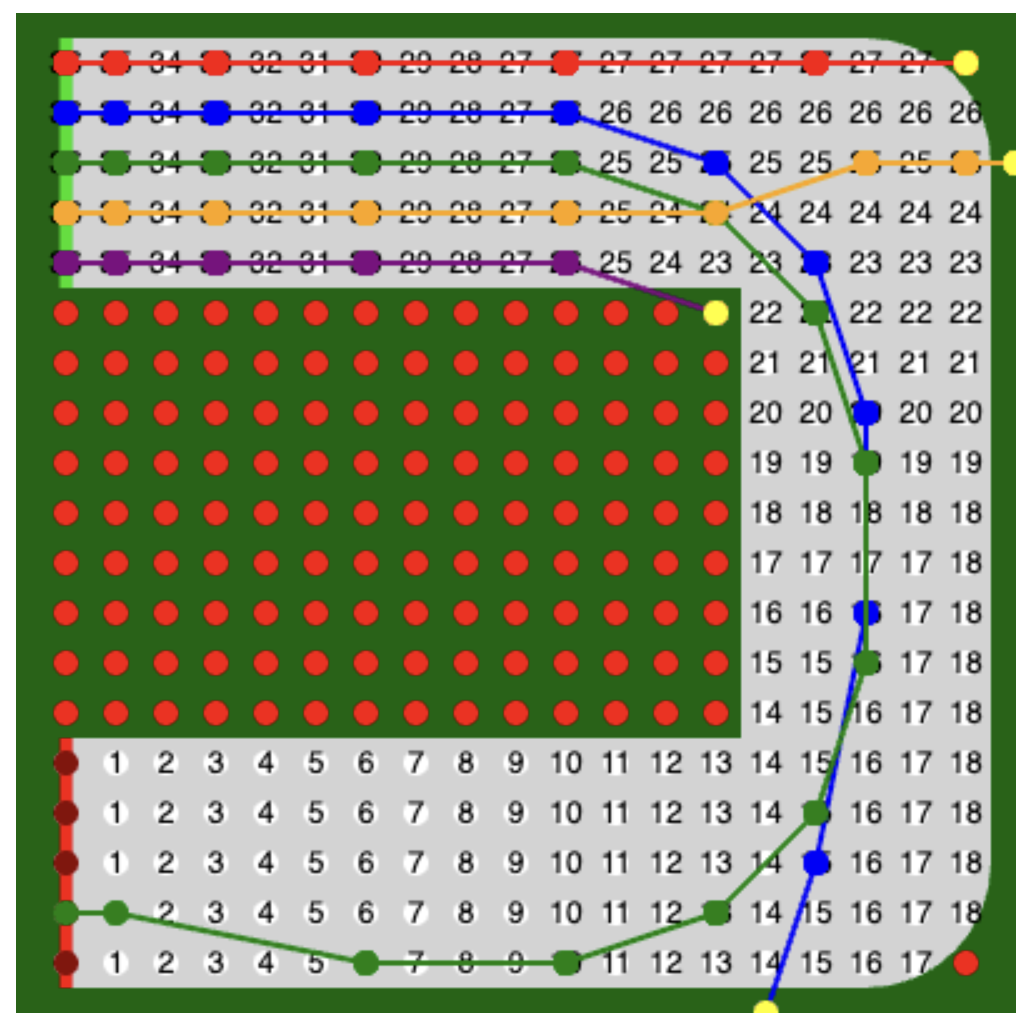Martin Gardner Racetrack Game
The code here allows you to simulate a game of Racetrack with one or more automated players.
Rules
The game presents you with a racetrack (path) overlaid on a grid of points. The race cars begin on the starting line, and attempt to reach the finish line (first).
As a driver, the only control you have is to adjust your current acceleration in the x and y directions. In this implementation, you can choose any combination of -1, 0, and +1 acceleration for each of x and y.
At each step, the simulator will calculate your new position and velocity on the grid, and ask you to choose your next move. Eventually, you will either crash (leave the track) or finish (cross the finish line).
If you want to play a similar simulator online manually, check out Vector Racer - not affiliated with this project.
CodePen Simulation
The easiest way to use this repo is to fork a copy of this CodePen.
Here you can see a number of different strategies racing against each other (only one of which is succeeding).
How to Program a Racer
If you use CodePen, there is only minimal boilerplate required to program a race.
// Import the racetrack library (and sample track) into CodePen
import { Racetrack, U_TRACK } from 'https://mckoss.com/racetrack/scripts/racetrack.js';
// Attach the a new Racetrack simulation to a <canvas> element
const rt = new Racetrack(document.getElementById('stage'), U_TRACK);
// This is where you register your racer. The callback function
// will be called once for each step of the race.
rt.race((state, options) => {
// Return a move as an [x, y] array.
// This strategy just keeps on accelerating in the x direction.
return [1, 0];
});
// Start the race
rt.run();
You are provided with two pieces of information at each step:
The car state:
{
status: 'running' | 'crashed' | 'finished' | 'error';
step: number;
position: Point;
velocity: Point;
crashPosition?: Point;
}
A Point is just a two-element array with an [x, y] coordinate.
status is a string with one of 4 values.
step starts and 1 and increments by one for each step of the race.
position is your car's current [x, y] coordinate on the racetrack.
Units here are in grid coordinates (not pixels).
velocity is is your car's current volocity. Note that the units are
relative to the grid points, not to pixels.
crashPosition is the point your car will go off the track if you
just coast at your current speed. If undefined, you car is either not
moving, or is coasting toward the finish line.
The second paramater of the racer callback function:
options is an array of the 9 distinct moves you could make and information
about the outcomes.
[
{
move: Point;
position: Point;
distanceToFinish: number | undefined;
status: 'ok' | 'crashed' | 'finished';
},
...
]
For each option you see what the move needed to get there (one of
[0, 0], [-1, -1], [-1, 0], ... etc.)).
The position you will end up.
The distanceToFinish (the total number of grid points to the finish line,
taking the shortest path). These are the number displayed in the grid, above.
And a status about whether that move will make you crash or cross the
finish line.
Designing your own Tracks
Tracks are implemented as a single path around a grid.
interface Track {
name: string,
dim: Point,
grid: number;
startLine: [Point, Point];
finishLine: [Point, Point];
trackWidth: number;
path: Point[];
}
dim Dimensions of the canvas element (in pixels).
grid The spacing of the grid (number of pixels between grid points).
startline The pixel coordinates of a line segment defining the starting
line.
finishLine Same for the finishing line.
trackWidth How wide the track path is in pixels.
path A sequence of points defining the centerline of the track (typically
drawns from the starting line to the finishing line).
The example U_TRACK is defined as:
{
name: "U-Track",
dim: [400, 400],
grid: 20,
startLine: [[20, 10], [20, 110]],
finishLine: [[20, 290], [20, 390]],
trackWidth: 100,
path: [[20, 60], [340, 60], [340, 340], [20, 340]],
}
Hosted Deployment
The currently deployed version of the project is at:
- https://mckoss.com/racetrack - Home page
- https://mckoss.com/racetrack/test/ - Unit test runner
- https://mckoss.com/racetrack/scripts/racetrack.js - ES6 Module for library
Using this Repo
Tools used:
- npm - Dependency management
- Typescript - Source code type checking
- mocha and chai - Testing framework
- vite - Code bundling and development mode.
- puppeteer - Headless browser for testing.
To use this repo, you should just be able to start with a relatively recent version of npm on your machine.
$ npm install # Install all dependencies.
$ npm run dev # Run a local development server
$ npm run build # Build the production and testing version of the code
$ npm test # Run all the unit tests.
The (vite) development server will start a local web server, and assemble the code supporting live reloading whenever and code is modified; giving you a very quick turn-around time for edit-debug loop.
Command line tests require that you build the production code first (at present).
$ npm run build && npm test
You can also run all the tests on a browser interactively via the web interface
at http://localhost:5173/test/ in dev mode.
The repo also runs a full build and test on github for every PR and deployment.
Repro Organization
The files in the repo are organized into the following files and folders:
/index.html- The home page rendering Racetrack./tools- Location of bash scripts using for building and testing./src- Source code files (in Typescript)./src/tests- All unit tests files./test- Static version of mocha-based browser test./docs- Markdown and images to document this repo./dist- (Build product) Production version of code goes here./public/scripts- (Build product) Raw Javascript library (ES6) modules fromtsccommand.
